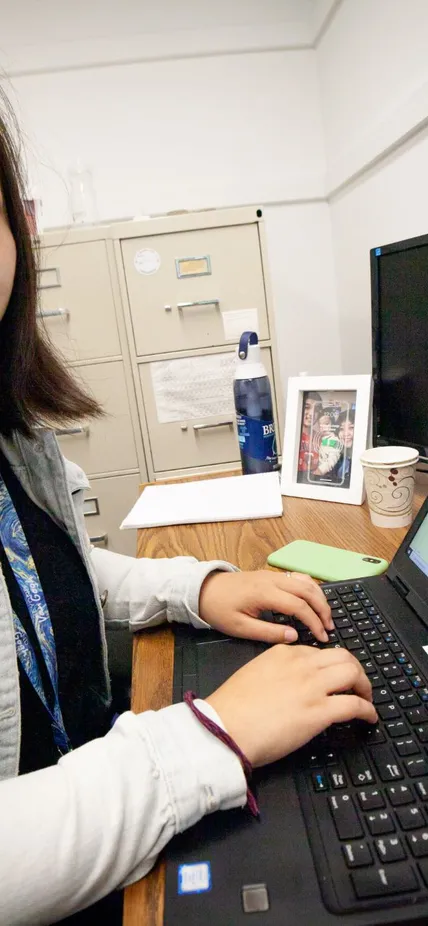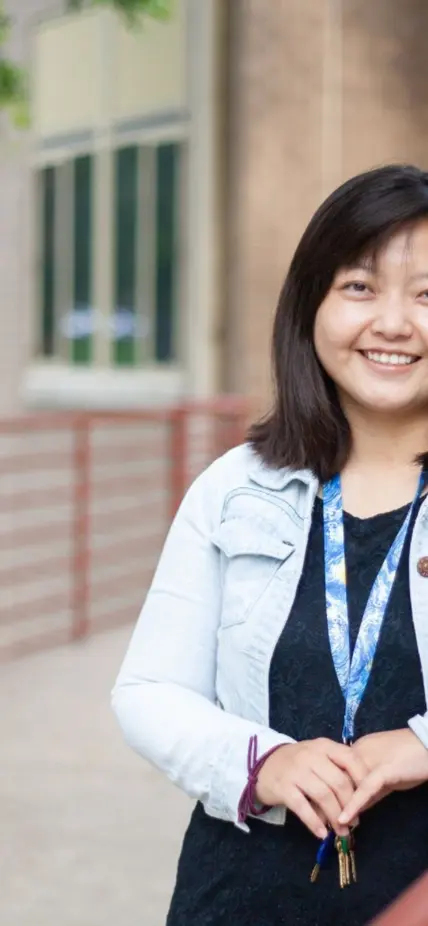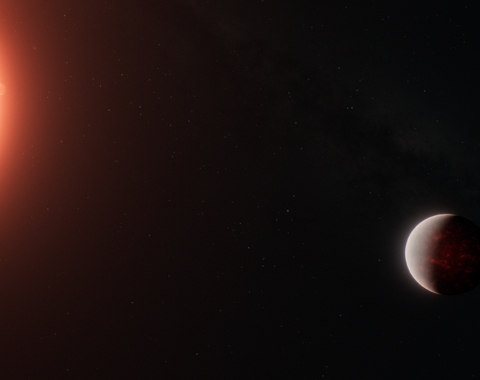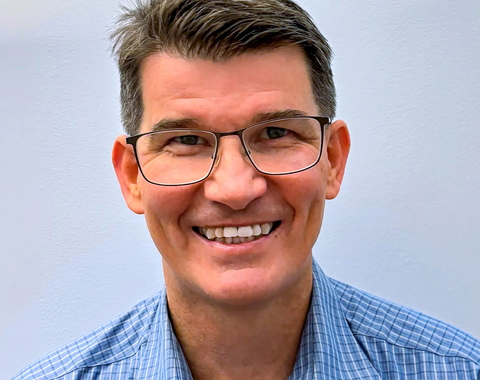Tiange Bi uses her interdisciplinary set of skills and computational expertise to predict the synthesis of new materials. Her research is primarily focused on crystal structure prediction of new clathrate structures and theoretical studies of the transport properties of iron alloys in the Earth and planetary cores.
Who are you, how long have you been at Carnegie?
My name is Tiange Bi and I’m currently a postdoctoral fellow at the Earth & Planets Laboratory, Carnegie Institution for Science.
I started on August 1st, 2021, and I work with Dr. Timothy Strobel and Dr. Ronald Cohen. I was born and grew up in Jinan, Shandon, China. I received my BS in chemistry from the University of Central Arkansas in 2013. Shortly after that, I studied chemistry at the State University of New York at Buffalo, and I was awarded a Ph.D. in 2020.
What is your area of research, and why is it important?
My research is concerned with computational materials design under extreme conditions.
My research mainly focuses on 1) crystal structure prediction of new carbon-based clathrate structures and optimization of superconducting transition temperatures, 2) calculating transport properties of iron alloys under the Earth and planetary cores’ conditions; 3) crystal structure prediction of novel superconducting hydrogen-rich materials.
Clathrates are molecular cages that can hold other atoms inside of them. The search for new carbon-based clathrate structures under pressure aims to identify potential superconducting materials with three-dimensional carbon networks that could also be hard and contain incompressible frameworks. Such compounds are not stable under ambient conditions, and pressure might be the solution to stabilize them.
Similarly, we are searching for hydrogen-rich materials that may be superconducting. Doping hydrogen with additional elements might bring down the required metallization, or even superconducting pressure of hydrogen.
On the other hand, the transport calculations I perform for iron alloys bring in both high pressure and high temperature to simulate the Earth or planet’s core conditions. My calculations on iron and iron alloys might be able to obtain both the electrical resistivity and thermal conductivities of these materials under the relevant pressure-temperature conditions.
What are the larger implications of your work?
Under pressure, compounds might assume stoichiometries and geometric arrangements that would not be accessible at atmospheric conditions. However, because high-pressure synthesis can be expensive to carry out and the results can be difficult to analyze, theoretical modeling is vital to predicting the chemical composition and required pressures and temperatures to synthesize compounds with useful properties.
My calculations on the carbon-based clathrate structures and hydrogen-rich materials might be able to assist experiments to obtain novel high-temperature superconducting materials. On the other hand, my theoretical calculation of transport properties of iron alloys might facilitate the understanding of Earth’s geodynamics, the thermal state of the core, and the evolution of Earth’s magnetic field.
What inspired you to choose this field of study?
Theoretical modeling of crystals requires knowledge in many fields including but not limited to physical chemistry, computer programing, material science, and geophysics. The interdisciplinary nature of this field of study motivates me to keep gaining new knowledge and shapes the way I think—not only for science but also in my daily life. This is why I chose this field of study.
In addition, because “materials under extreme conditions” is a frontier topic in science, the frequently updated information, new ideas, and challenges inspire me to keep going and ignite my passion for science!
What would you say is the biggest challenge in your work?
The interdisciplinary nature of computational material design was one of the major reasons I chose the field, but it is also the most challenging part. It requires a broad range of knowledge and skills from different fields. If I fall behind on any fields that might be required by my current project, I have to pause and get myself updated!
Can you summarize your two recent publications on the prediction of hydrogen-rich materials under pressure?
The first article, “the Li–F–H ternary system at high pressures”, discusses our study on the ternary hydride system of Li–F–H (Lithium-Fluoride-Hydrogen) in various concentrations at 300 GPa.
Lithium has been used as a pressure-transmitting medium in diamond anvil cells, as well as window materials in dynamic compression experiments. Therefore, it is important to understand the possible reactivity between the hydrogen (found frequently in samples) and lithium fluoride (LiF) under pressure. From our study, we identified six metastable ternary phases that might be synthesizable, and they contain unique bifluoride, trifluoride, and H3+ ions. One of these phases, Li3F4H was predicted to be thermodynamically and dynamically stable after releasing the pressure.
Another work I published recently is “Electronic Structure and Superconductivity of Compressed Metal Tetrahydrides”. This study analyzes a unique crystal structure (ThCr2Si2-type) that was predicted to be assumed by many high-pressure alkaline and rare earth metal tetrahydrides and is also assumed by more than 700 AB2X2 compounds. We analyzed the bonding, and geometry evolution of the structure under pressure, and showed that the presence of quasimolecular H2 units within the phases is the key to their superconductivity.
Bi, Tiange, et al. "The Li–F–H ternary system at high pressures." The Journal of Chemical Physics 154.12 (2021): 124709.
Bi, Tiange, and Eva Zurek. "Electronic Structure and Superconductivity of Compressed Metal Tetrahydrides." Chemistry–A European Journal (2021).
What's next for you? Any projects coming up?

Tiange Bi uses computational chemistry to predict new materials and develop the roadmap used to synthesize them.
I started my position in August, so I have a lot of new projects that I’m working on including the prediction on carbon-based clathrates, M-B-C ternary systems, and transport calculations for Fe and Fe alloys.
Dr. Timothy Strobel and colleagues have carried out both experimental and theoretical investigations on carbon-based clathrate structures and successfully synthesized Sr/La@B3C3. This motivated me to study another carbon-based clathrate (type I) system with a total number of 46 B/C atoms forming the cage. I carry out structure predictions on various boron-carbon compositions with metals from groups I, II, and III of the periodic table as guest elements.
In addition, I carry out crystal structure predictions on M-B-C (M = metal, B= Boron, C= Carbon) systems under pressure trying to identify any new arrangements with three-dimensional carbon networks. The goal of this project is to gain an understanding of the desired pressures and compositions to obtain such phases.
Meanwhile, I’m performing resistivity calculations on hexagonal close-packed (hcp) Fe and Fe-Si systems under high pressure and high temperature up to their melting curve to check whether they show resistivity saturation—when a metal’s resistivity hits a limit and stops increasing with temperature. Although there are earlier simulations carried out on these systems, we are testing the viability of a different method, coherent potential approximation (CPA), which is faster and computationally cheaper. If the method works, we can apply it to study a much broader range of systems, including but not limited to Fe-C, Fe-O, and Fe-S. The thermal and electrical conductivity of these systems is essential to understanding how the Earth formed.
For a bigger picture in the future, I believe I will broaden my study to cover other types of carbon-based clathrate structure and other types of alloys of metals.
How has your background influenced your research?
Due to my strong interest, I was motivated to gain extra training in mathematics and science since I was young. As my skill and knowledge accumulated, I realized that physical chemistry is a great combination of mathematics, chemistry, physics, and material science. Therefore, I joined Prof. Eva Zurek’s research lab in the department of chemistry at the State University of New York at Buffalo to be trained as a theoretician focusing on material modeling.
My background provides me the knowledge, skill, and, most importantly, experience, that is fundamental for me to be able to carry out my research.
Has anything else affected your thinking as a scientist
I believe my family’s support has positively influenced how I think as a scientist. Because of the support, I was able to stay objective and patient in work.
My Ph.D. advisor, Prof. Eva Zurek, provided many opportunities for me to work on various types of projects and to connect with other scientists in the field. This allowed me to jump out of my comfort zone and think about each project from different angles.
When you're not actively researching, do you have any hobbies?
I enjoy traveling during my leisure time, especially visiting national parks. The fresh air makes me relaxed, and nature’s beauty can also refresh my mind. The surprises and challenges of nature are exciting. I am also collecting stamps from national parks, but there is still a long way to go!
Why did you choose the Earth and Planets Laboratory?
I had the honor to collaborate with scientists from the Earth and Planets Laboratory during my Ph.D. years, and I was grateful that I had a chance to visit the site a couple of years ago during a conference that was held in Washington D.C. Such experiences allowed me to gain some understanding of the culture, goals, and work environment of EPL.
In addition, I believe that the opportunity for interdisciplinary collaborations within EPL will bring my career, skill, and experience to a higher level. Joining EPL has already broadened my research topics and skills, and therefore will provide me a better view as a scientist!
Do you have any advice for current graduate students?
I believe it is important to be dedicated as a scientist and to have a commitment to research. At the same time, graduate students are starting their careers and getting trained to be future scientists, it is more important for them to make sure they would enjoy their work, stay motivated, and value their own achievements.
Do you remember the first time you thought you'd be a scientist?
An interesting fact about me is that I noticed that I had a strong interest in mathematics and science since I was young—probably since I was in elementary school. Both of my parents are medical doctors and have been giving me full support, both financially and emotionally, to pursue my dream of becoming a scientist.
What's your favorite rock or mineral?
My favorite rock has to be diamond! The romance meaning of diamond is fascinating, but what attracts me more is the fact that diamond is formed under high pressure, remains metastable after quenching, possess three-dimensional networks with strong covalent bonds, is super hard, and can be used in the diamond anvil cell to apply pressure to synthesize other materials!



